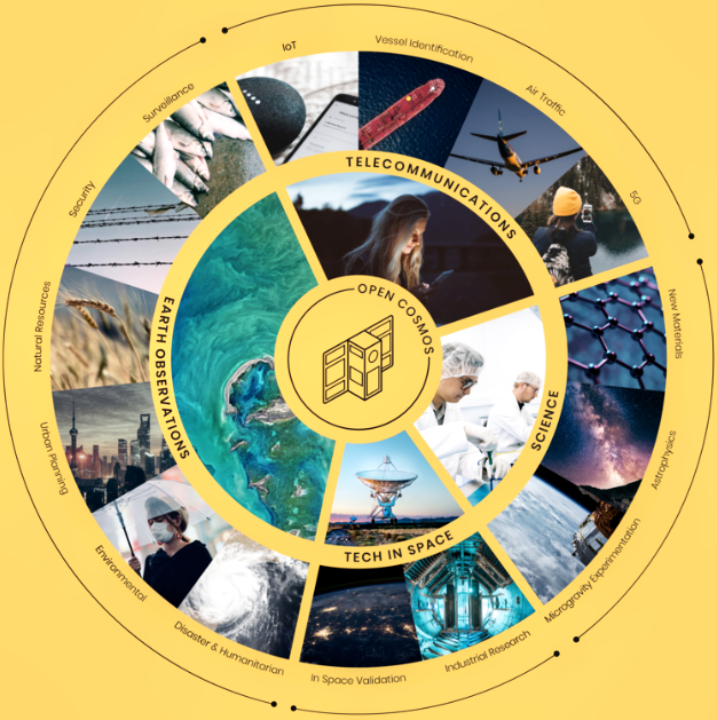
Open Cosmos has announced their latest contract with the European Space Agency (ESA) on the NanoMagSat mission concept.

The NanoMagSat mission concept consist of a smallsat constellation to monitor the Earth’s magnetic field and ionospheric environment with an innovative revisiting time strategy and combination of instruments (one self-calibrated absolute scalar/vector magnetometer combined with star trackers on an optical bench, one high frequency vector magnetometer, a multi-needle Langmuir probe and two, dual frequency, GNSS receivers for recovery of Total Electron Content and ionospheric radio-occultation data).
The mission concept is proposed by a consortium from European entities. Open Cosmos, is responsible for the satellite and mission concept aspects. The French technology research institute CEA-Leti is focused on overseeing the payload and developing the magnetometers; University of Oslo is providing the Langmuir probes; and Spanish engineering companies Comet Ingenieria and Prosix Engineering are providing the deployable boom and optical bench. The Université Paris Cité’s IPGP, is the scientific lead of the mission.
NanoMagSat was selected as an ESA Scout candidate for an initial feasibility consolidation phase in 2020. The aim of this new activity is to de-risk all critical technical elements with the aim to propose NanoMagSat as a mission candidate in potential future calls of SCOUTs. These critical elements include a deployable boom, electronic components of the magnetometers and Langmuir probes, as well as the development of a satellite with a low electromagnetic signature. All these are key to ensuring that the payload matches the requirements to detect the targeted signals and meet the mission’s goals.
The activity will develop new technologies for expanding the roles smallsats can play in such missions: For instance, the boom needs state-of-the-art mechanical engineering to provide long arm deployment, compact packing, and very specific materials to maximise magnetic cleanliness. Similarly, all elements of the small satellite platform also need to be optimised for this.
Once these elements are de-risked, this will help Open Cosmos and the consortium to propose a mission concept aiming to cost less than €30 million and to be developed within three years, a fraction of the cost that such important complementary scientific missions have been in the past.
The current ESA Swarm satellites have been monitoring Earth’s magnetic field and ionospheric environment since 2013. They have helped researchers make a large number of scientific discoveries in regards to the dynamics driving their evolution, solar storms, the way the magnetic field organises the magnetosphere and ionosphere, the geology of what’s beneath Antarctica’s ice sheets, and even the migratory patterns of animals.
The consortium proposes a novel approach using a new constellation concept and low-cost small satellites to increase the temporal resolution at which the various components of Earth’s magnetic field can be recovered, as well as using a well-chosen payload to initiate new ways of sounding the ionospheric environment.
The innovative orbital strategy of combining a satellite in polar orbit together with two orbits inclined at 60° would provide an improved temporal revisit (the time it takes to return to and acquire data from the same location at the same time) of a little more than one month for latitudes within 60°N/S. It is also designed to work in conjunction with Swarm, should Swarm still be in operation at the time of launch. The approach is fully scalable with additional satellites that could be added to further increase this performance.
The Earth’s magnetic field protects our planet from damaging incoming energetic charged particles such as those coming from the Sun. The Earth’s magnetic field also organizes the way the near outer space (the magnetosphere) and the ionized upper layers of the atmosphere (the ionosphere) respond to solar activity.
This response can produce strong magnetic signals that can affect ground technology such as power transmission networks or, potentially, internet networks. It can also create radiation hazards affecting satellites in near outer space, and multiple ionospheric perturbations that can severely perturb radio transmissions, radars and GNSS systems – a group of hazards collectively known as space weather hazards.
Monitoring Earth’s magnetic field and ionospheric environment is key for investigating these phenomena, understanding their evolution and unraveling the underlying mechanisms, so we can better prepare for them in the future. It is also essential to aid accurate navigation, reveal properties of the shallow and deep Earth, and provide key information for geophysical surveying of minerals.
Florian Deconinck, Vice President of Institutional Partnerships & Future Missions at Open Cosmos, said, “This contract is a landmark for Open Cosmos and for the NanoMagSat mission concept. It is a concrete step towards making this mission concept feasible which if implemented would complement and expand on the results from renown missions like Oersted, CHAMP or Swarm. More generally it illustrates how ESA, the industry and academia can work together to show the potential of future micro-satellite constellation missions to significantly contribute towards big scientific challenges.”
Gauthier Hulot, PI of the project, Deputy Director for Science and Space at IPGP, Université Paris Cité, said, “It is crucial that monitoring of Earth’s magnetic field and ionospheric environment currently achieved by the ESA Swarm mission is maintained and improved beyond this very successful mission. This contract is a major step towards ensuring NanoMagSat can be launched soon enough to achieve this and demonstrate the possibility of permanently maintaining such observations with the help of low-cost scalable small satellite constellations.”
Open Cosmos designs, manufactures and operates satellites to solve the world’s biggest challenges. Open Cosmos is the perfect partner for those who want to monitor changes on Earth at a global scale, those who want to provide telecommunications services based on satellite constellations and those who want to test innovative space technologies in orbit. For more information visit www.open-cosmos.com, our Twitter and LinkedIn.
